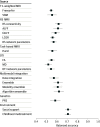A Systematic Evaluation of Machine Learning-Based Biomarkers for Major Depressive Disorder
- PMID: 38198165
- PMCID: PMC10782379
- DOI: 10.1001/jamapsychiatry.2023.5083
A Systematic Evaluation of Machine Learning-Based Biomarkers for Major Depressive Disorder
Abstract
Importance: Biological psychiatry aims to understand mental disorders in terms of altered neurobiological pathways. However, for one of the most prevalent and disabling mental disorders, major depressive disorder (MDD), no informative biomarkers have been identified.
Objective: To evaluate whether machine learning (ML) can identify a multivariate biomarker for MDD.
Design, setting, and participants: This study used data from the Marburg-Münster Affective Disorders Cohort Study, a case-control clinical neuroimaging study. Patients with acute or lifetime MDD and healthy controls aged 18 to 65 years were recruited from primary care and the general population in Münster and Marburg, Germany, from September 11, 2014, to September 26, 2018. The Münster Neuroimaging Cohort (MNC) was used as an independent partial replication sample. Data were analyzed from April 2022 to June 2023.
Exposure: Patients with MDD and healthy controls.
Main outcome and measure: Diagnostic classification accuracy was quantified on an individual level using an extensive ML-based multivariate approach across a comprehensive range of neuroimaging modalities, including structural and functional magnetic resonance imaging and diffusion tensor imaging as well as a polygenic risk score for depression.
Results: Of 1801 included participants, 1162 (64.5%) were female, and the mean (SD) age was 36.1 (13.1) years. There were a total of 856 patients with MDD (47.5%) and 945 healthy controls (52.5%). The MNC replication sample included 1198 individuals (362 with MDD [30.1%] and 836 healthy controls [69.9%]). Training and testing a total of 4 million ML models, mean (SD) accuracies for diagnostic classification ranged between 48.1% (3.6%) and 62.0% (4.8%). Integrating neuroimaging modalities and stratifying individuals based on age, sex, treatment, or remission status does not enhance model performance. Findings were replicated within study sites and also observed in structural magnetic resonance imaging within MNC. Under simulated conditions of perfect reliability, performance did not significantly improve. Analyzing model errors suggests that symptom severity could be a potential focus for identifying MDD subgroups.
Conclusion and relevance: Despite the improved predictive capability of multivariate compared with univariate neuroimaging markers, no informative individual-level MDD biomarker-even under extensive ML optimization in a large sample of diagnosed patients-could be identified.
Conflict of interest statement
Figures



References
MeSH terms
Substances
LinkOut - more resources
Full Text Sources
Miscellaneous

